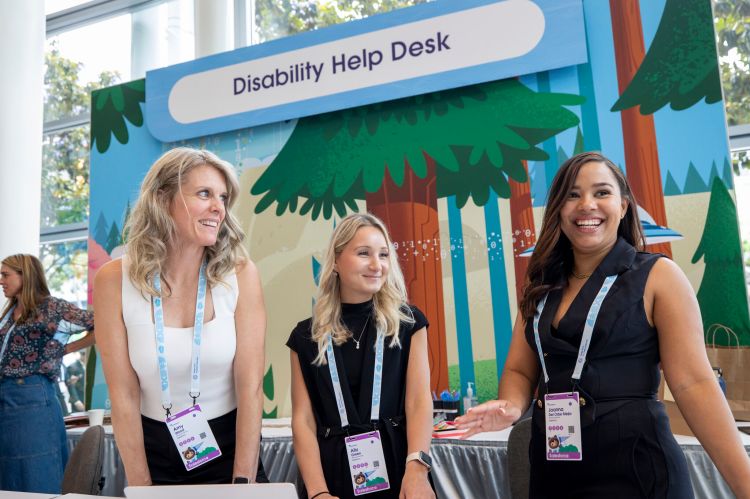Want to Reach More People? Make Your Events Accessible



By fostering a culture of learning and accountability around accessibility, organizations stay ahead of the curve as expectations and best practices evolve.
Whether it’s a global conference, community gathering, or workplace meeting, events are meant to bring people together. They’re meant to inform, inspire, and ignite action. But too often, accessibility is treated as an afterthought rather than a foundational element of event planning. When spaces — physical, digital, or hybrid — aren’t designed with everyone in mind, they send a clear message about who is welcome and who is not.
Accessible events make room for the abilities of everyone. Because when events are accessible, they don’t just meet the needs of people with disabilities, they become more innovative and impactful for everyone involved. Ensuring events are accessible isn’t just a matter of compliance, it’s a business imperative.
Accessibility expands reach and engagement
Providing features such as sign language interpretation, captioning, assistive technology, screen reader compatibility, quiet spaces, and accessible physical spaces help ensure people of all abilities can fully participate. When accessibility is prioritized, event attendance, engagement, and satisfaction increase across the board.
In the United States, more than 1 in 4 adults have a disability, and according to the World Health Organization (WHO), an estimated 1.3 billion people worldwide have disabilities. This represents 16% of the global population, or 1 in 6 of us. So it’s no surprise that this demographic holds a significant amount of global spending power — approximately $490 billion in the U.S. alone, and $13 trillion globally. Keeping these numbers in mind, ensuring that events are accessible isn’t just the right thing to do from an ethical and legal standpoint, it’s also a smart business decision.
“As a leader in human capital management, Workday understands that accessible events are fundamental to creating an environment where everyone feels included and has a positive experience,” said Workday Director of Disability Inclusion Stacey Romero. “When our customers trust us with their people and their money, they expect us to get this right; to make sure our events are for everyone.”
Disability inclusion leads to higher satisfaction, stronger brand reputation, and increased business opportunities. According to a research report by Accenture, businesses that prioritize accessibility outperform their peers in terms of market share and customer loyalty. Specifically, companies that have led on key disability inclusion criteria saw 1.6 times more revenue, 2.6 times more net income, and two times more economic profit compared to their competitors.
By prioritizing accessibility, event organizers can expand their audience and ultimately boost their bottom line. Whether it’s conferences, concerts, festivals, or corporate gatherings, creating events that welcome everyone benefits not only people with disabilities but also businesses and society as a whole.
Employees want accessible workplaces
Companies that have disability accommodations have higher levels of employee retention. Events are an extension of workplace culture, and accessible events signal to current and prospective employees that accessibility is an organizational priority — making these organizations more appealing to top talent. “When accessibility is part of your culture, not just your compliance, it shows and people feel it,” said Amy Wood, manager of accessible events and real estate/travel at Salesforce.
According to a study by Deloitte, six in 10 people have been unable to attend some kind of work event due to accessibility challenges. One-third of people have been unable to attend a work event at their workplace because of venue inaccessibility, and nearly four in 10 (38%) were unable to attend a work event outside of the workplace for the same reason. These numbers underscore the real consequences of inaccessibility: disengagement and missed opportunities for connection. On the flip side, accessible events help organizations live their values and create a culture where everyone, regardless of ability, can participate and belong.
Driving innovation
Many accessible solutions benefit everyone, not just people with disabilities. Captions help attendees in noisy environments or those who are non-native speakers. Clear visual design and accessible language improve understanding for everyone. These “curb-cut effects” — named after sidewalk ramps that benefit both wheelchair users and people pushing strollers or carts — show how accessibility often leads to better overall design and user experience.
Additionally, building accessible events often pushes companies to adopt cutting-edge technology, train staff more thoroughly, and think creatively. All of which can enhance innovation and operational excellence. “Accessibility unlocks potential for attendees, companies, and the future of events. It’s not just an accommodation, it’s an advantage,” said Wood.
The value of collaboration
From creating open lines of communication with people with disabilities to ensure their needs are met, to learning from peers and partners in the industry, ensuring accessibility at events isn’t a task that can be addressed in isolation — it requires collaboration.
For example, Salesforce and Workday have collaborated for more accessible events. Inspired by the accessibility of Salesforce events like Dreamforce, World Tour, and Connections, Romero reached out to Wood, who consults across teams at Salesforce to ensure event accessibility. (Wood’s team created an accessible guide to Dreamforce 2025 that covers what to expect at the event.)
“I reached out to Amy on LinkedIn because I’d seen articles and resources that she’d shared and a webinar she had done with a few other people from Salesforce for Disability:IN,” said Romero.
This outreach led to a valuable knowledge exchange, with Wood sharing best practices, checklists, and insights that helped inform Workday’s accessibility strategy. Workday Rising, which hosted more than 20,000 attendees in Las Vegas last year, introduced a Disability Help Desk modeled after Salesforce’s approach and refined its accommodation request process, ensuring proactive support for ASL interpretation and other accessibility needs.
Creating accessible events isn’t a one-time task. It’s an ongoing process that requires continuous learning, feedback, and evolution. Leaders in the accessibility space understand that needs vary and technologies shift, so staying informed and adaptable is essential.
“Accessibility requires more than a static approach; it demands an ongoing commitment to growth and progress,” said Romero. “As long as people see us moving forward and actively finding ways to help, I think they will understand and appreciate the effort.”
Companies that invest in empowering their teams to lead with accessibility — through training, resources, and design practices — are better positioned to anticipate barriers, respond with innovation, and ultimately create more accessible experiences. By fostering a culture of learning and accountability around accessibility, these organizations not only meet today’s standards but also stay ahead of the curve as expectations and best practices evolve.
The Accessible Guide to Dreamforce
We’re committed to creating an accessible and welcoming experience for all guests in October at at Dreamforce, the biggest AI event of the year.




























